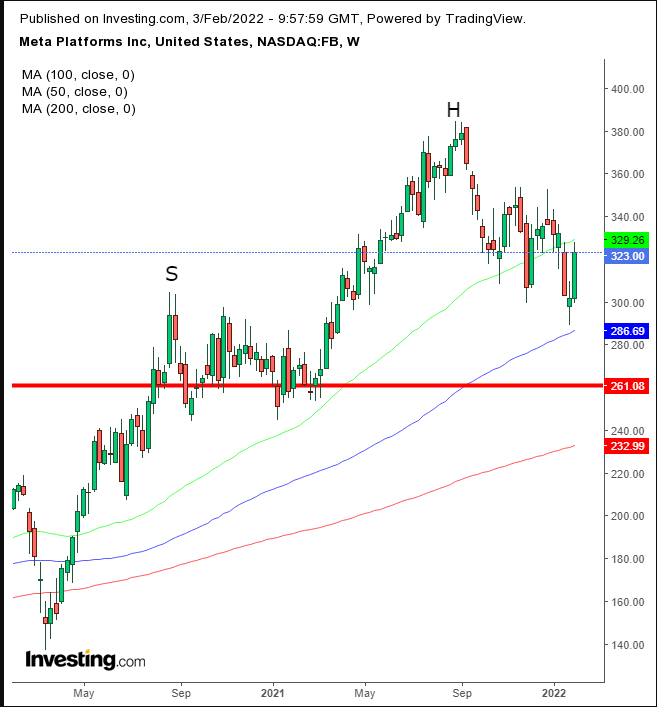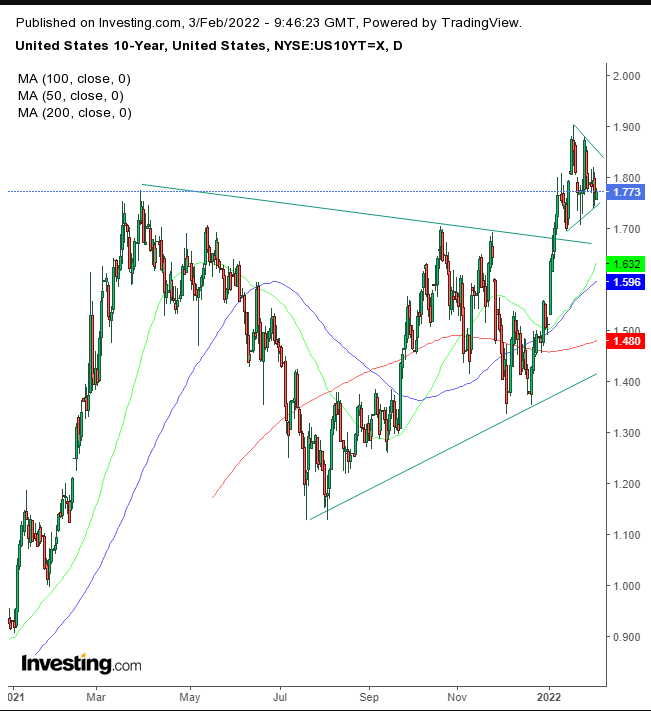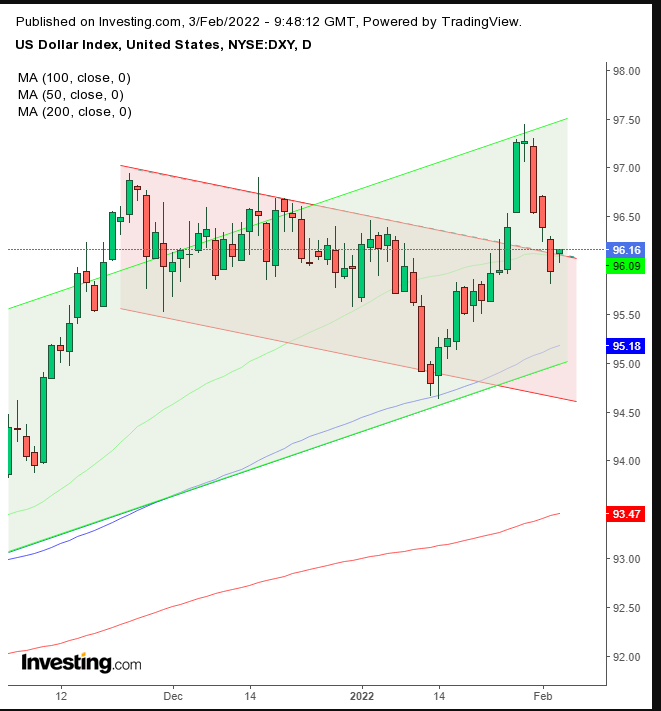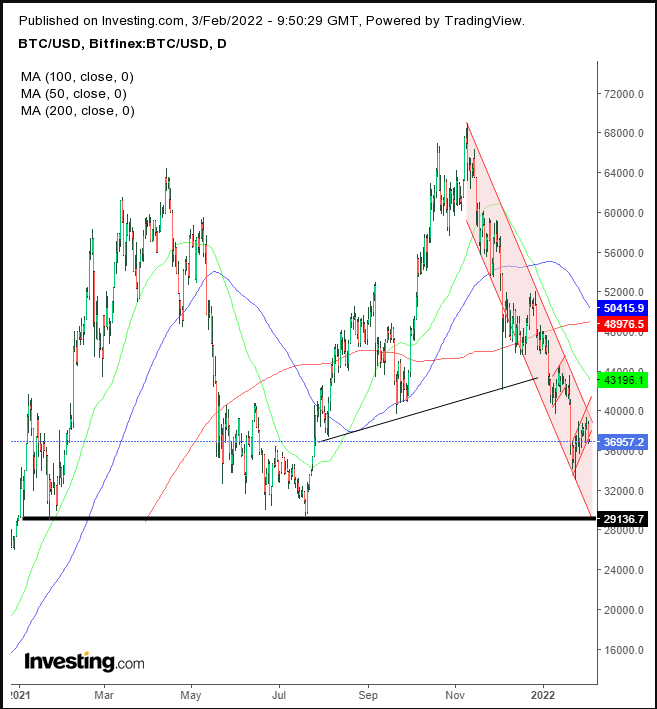- Meta Platforms slumps 20% in pre-market
- US Dollar rebounds after three-day selloff
- Oil prices slip
Key Events
US futures on the Dow Jones, S&P 500, NASDAQ and Russell 2000 and regional stocks ended the global rally on Thursday following shocking earnings misses by US mega-cap technology stocks on Wednesday after the closing bell on Wall Street.
This earnings season's solid results had boosted stocks, kickstarting a recovery from January's selloff, but that's no longer the case today. Investors are now awaiting any additional guidance from the Fed on interest rates, after comments from six members earlier this week seemed to pull back from Chair Jerome Powell's hawkish tilt in January.
Global Financial Affairs
NASDAQ futures led the decline in US contracts this morning, erasing over 2% of their value. On the opposite end of the growth-vs-value scale, contracts on the Dow Jones retreated just 0.3% at time of writing.
The culprit for all this disruption: Facebook owner Meta Platforms (NASDAQ:FB). The company's shares have been sinking in pre-market trade, currently down more than 20% after the social media company yesterday disappointed on guidance.
NASDAQ futures have been dragged down as well by the frenzy. A transition from the pre-market numbers to regular trading with the same prices will erase more than 20% of the company's value.

The red line is where FB stock will likely open according to its pre-market price, perhaps forming a H&S top.
After disappointing profits, Dutch multinational banking and financial services institution ING (AS:INGA) led the STOXX 600 Index into losses.
Earlier, Asian stocks were uneven, with markets in China remaining closed for Lunar New Year Holidays. South Korea's KOSPI outperformed regional benchmarks, rising 1.67%, as local traders caught up after the holiday there.
Japan's Nikkei 225 plunged 1.06%, capping a four-day winning streak, with technology companies pressured by sour sentiment on the sector following the post-US session earnings misses.
US stocks are selling off in the pre-market, after yesterday's late-day disappointments, casting a shadow over today's US session. We have been questioning whether dip buyers have gone too far, presuming stocks will always rebound as they have since the Fed has been providing a solid safety net with unprecedented accommodation.
It appears that even after a slew of policymakers talked down aggressive tightening, dip buyers got a reality check in late trading. Other tech shares in the negative spotlight: Spotify (NYSE:SPOT) dropped about 5.75% after publishing its corporate report card and has fallen over 8% in premarket trading. Electric vehicle maker Tesla (NASDAQ:TSLA) was also dragged down by the sector, losing 2.75%.
The slew of significant earnings misses shocked investors, who had been elated by solid Alphabet (NASDAQ:GOOGL) and Advanced Micro Devices (NASDAQ:AMD) reports just 24 hours earlier. This whipsawing of sentiment is a sign of how exceptionally volatile the market is currently, as corporates endure the most significant economic disruptions since World War II as well as the highest inflation in decades due to the global coronavirus pandemic.
Treasury yields on the 10-year note were little changed after rebounding from earlier losses.

Rates bounced off the bottom of a symmetrical triangle, which developed after completing a substantial symmetrical triangle since March. Rising yields are expected to dent equities, as investors price in shrinking liquidity and higher borrowing costs. In addition, rising yields provide an attractive alternative investment to stocks.
The dollar opened higher.

The greenback rebounded above a broken falling channel, resuming trading along its rising track.
In a mirror image of the dollar, gold slipped.
Bitcoin continued to move lower.

The cryptocurrency is flirting with a downside breakout of a rising, bearish flag, the second in a row. Before that, it completed an H&S top with an implied target that suggests a much more significant double-top reversal.
If BTC's supply and demand operate according to the principles of technical analysis, we could see it heading toward multi-year lows. However, historical trading patterns suggest that at its current level, Bitcoin may offer value.
Oil opened lower, below $88 a barrel. At yesterday's OPEC+ meeting the cartel voted unanimously to increase production. However, rather than increased production quotas boosting the commodity, rising tensions over Ukraine continue to prop up the price.
Up Ahead
- After the US close on Thursday Amazon (NASDAQ:AMZN) reports Q4 2021 results.
- On Friday Canada reports employment data.
- Nonfarm payrolls report for January is published on Friday.
Market Moves
Stocks
- The STOXX 600 fell 0.2%
- Futures on the S&P 500 fell 0.8%
- Futures on the NASDAQ 100 fell 1.8%
- Futures on the Dow Jones Industrial Average were little changed
- The MSCI Asia Pacific Index fell 0.3%
- The MSCI Emerging Markets Index was little changed
Currencies
- The Dollar Index rose 0.2%
- The euro rose 0.33% to $1.1280
- The Japanese yen fell 0.2% to 114.83 per dollar
- The offshore yuan rose 0.1% to 6.3642 per dollar
- The British pound fell 0.2% to $1.3556
Bonds
- The yield on 10-year Treasuries was little changed at 1.78%
- Germany's 10-year yield rose 20% to 0.04%
- Britain's 10-year yield advanced one basis point to 1.27%
Commodities
- WTI crude fell 1.18% to $87.44
- Brent crude lowered 1.21% to $88.38
- Spot gold fell 0.1% to $1,804.88 an ounce
